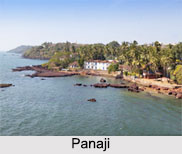 Capital Cities of West India clearly identify the strength of nation"s economy along with the best cuisine and rich cultural and historical heritages. These capitals are Mumbai, the capital city of Maharashtra, Gandhinagar, the capital city of Gujarat, and Panaji or Panjim the capital city of Goa. According to the history of India, these capital cities of western part of India have evolved from 1st Century BC. The archaeological evidences proves that parts of Gujarat were the site of Indus Valley Civilization which includes Lothal and Surkotada, while the western part of India was ruled by the rulers of Rashtrakuta Dynasty, the Maurya Empire, Gurjars, Rajputs, Satavahana Dynasty, Western Satraps, Indo Greeks, and Kadamba Dynasty. The major populations in these capital cities are Hindus; and Muslims are the minor. The Parsis settle in Gujarat and the adjacent areas where the Jains and Buddhists are found in Surat. Most of the Christians live in Goa. When talking about the culture, the culture of Goa, Maharashtra and Gujarat are distinctive and varied. They are not similar to Eastern part of India. The Maharashtran culture, Goan culture and the Gujrati culture are having the distinctive looks.
Capital Cities of West India clearly identify the strength of nation"s economy along with the best cuisine and rich cultural and historical heritages. These capitals are Mumbai, the capital city of Maharashtra, Gandhinagar, the capital city of Gujarat, and Panaji or Panjim the capital city of Goa. According to the history of India, these capital cities of western part of India have evolved from 1st Century BC. The archaeological evidences proves that parts of Gujarat were the site of Indus Valley Civilization which includes Lothal and Surkotada, while the western part of India was ruled by the rulers of Rashtrakuta Dynasty, the Maurya Empire, Gurjars, Rajputs, Satavahana Dynasty, Western Satraps, Indo Greeks, and Kadamba Dynasty. The major populations in these capital cities are Hindus; and Muslims are the minor. The Parsis settle in Gujarat and the adjacent areas where the Jains and Buddhists are found in Surat. Most of the Christians live in Goa. When talking about the culture, the culture of Goa, Maharashtra and Gujarat are distinctive and varied. They are not similar to Eastern part of India. The Maharashtran culture, Goan culture and the Gujrati culture are having the distinctive looks.
Mumbai
 It is the capital of Maharashtra and it is known as the "City of Dreamers". Here it is the commercial capital of India along with Bollywood, which is number one in cultural-business market in India and in the world. The nightlife here is urban and posh. Beaches are a major tourist attraction in the city. Mumbai has major beaches like Girgaum Beach, Chowpatty Beach, Juhu Beach, Dadar Chowpatty Beach, Gorai Beach, Marve Beach, Versova Beach, Madh Beach, Aksa Beach and Manori Beach.
It is the capital of Maharashtra and it is known as the "City of Dreamers". Here it is the commercial capital of India along with Bollywood, which is number one in cultural-business market in India and in the world. The nightlife here is urban and posh. Beaches are a major tourist attraction in the city. Mumbai has major beaches like Girgaum Beach, Chowpatty Beach, Juhu Beach, Dadar Chowpatty Beach, Gorai Beach, Marve Beach, Versova Beach, Madh Beach, Aksa Beach and Manori Beach.
Gandhinagar
The city of temples and the city of Mahatma Gandhi- Gandhinagar is the capital of Gujarat. The Akshardham temple is the face of Gandhinagar allures the large number of tourists. The main economic base of Gandhinagar is the textile mills and this city serves the best communication with all the cities of Gujarat including the neighbouring states like Maharashtra and Rajasthan.
Panaji
Panaji or Panjim in Portuguese language is the capital of the Indian state of Goa and the headquarters of North Goa district. It lies on the banks of the Mandovi River estuary in the Tiswadi taluka. The Baroque Our Lady of the Immaculate Conception Church is located overlooking the main square known as Praça da Igreja. The colourful villas, cobbled streets and interesting buildings give Panaji a Portuguese ambience in India.



















